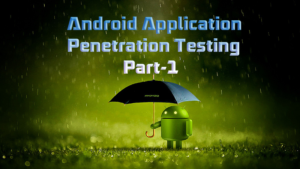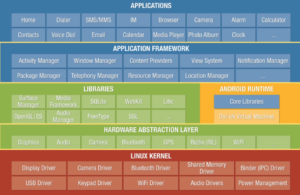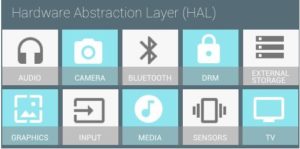[et_pb_section admin_label=”section”]
[et_pb_row admin_label=”row”]
[et_pb_column type=”4_4″]
[et_pb_text admin_label=”Text”]

After web applications more concern area is mobile application penetration test Let’s start with some basics-
Basic architecture for android device

Linux kernel
For hardware, we always required drivers as software so that those hardware can smoothly work. We choose Linux kernel because it has Security features like
- A user-based permissions model
- Process isolation
- Extensible mechanism for secure IPC
- The ability to remove unnecessary and potentially insecure parts of the kernel
Hardware Abstraction Layer just gives Applications direct access to the Hardware resources.
Bluetooth, audio, radio are examples

On top of Hardware Abstraction Layer sits a layer that contains some of the most important and
Useful libraries as follows:
- Surface Manager: This manages the windows and screens
- Media Framework: This allows the use of various types of codecs for playback and recording of different media
- SQLite: This is a lighter version of SQL used for database management
- WebKit: This is the browser rendering engine
- OpenGL: This is used to render 2D and 3D contents on the screen properly the libraries in Android are written in C and C++
Dalvik Virtual Machine which is specifically designed by Android Open Source Project to execute application written for Anroid. Each app running in the Android Device has its own Dalvik Virtual Machine.
Android Runtime (ART) is an alternative to Dalvik Virtual Machine which has been released with Android 4.4 as an experimental release, in Android Lollipop (5.0) it will completely replace Dalvik Virtual Machine. Major change in ART is because of ahead-of-time (AOT) Compilation and Garbage Collection.In Ahead-of-time(AOT) Compilation ,android apps will be compiled when a
In Ahead-of-time(AOT) Compilation ,android apps will be compiled when user installs them on their device whereas in the Dalvik used Just-in-time(JIT) compilation in which bytecode are compiled when the ser runs the app.
Moving to the last one, these are common.From Android Version 4.4, there is also the availability of another runtime called Android Runtime (ART), and the user is free to switch between the DVM and the ART Runtime environments
Application Framework
The Application Framework layer provides many higher-level services to applications in the form of Java classes. Application developers are allowed to make use of these services in their applications.

The Android framework includes the following key services
Activity Manager- application lifecycle and stack are controlled by activity manager
Content Provider-
Content Provider component supplies data from one application to others on request.
You can store the data in the file system, an SQLite database, on the web, or any other persistent storage location your app can access.
Through the content provider, other apps can query or even modify the data (if the content provider allows it).
Content Provider is useful in cases when an app wants to share data with another app.
Resource Manager – Provides access to non-code embedded resources such as strings, colour settings and user interface layouts.
Notifications Manager – Allows applications to display alerts and notifications to the user.
View System – An extensible set of views used to create application user interfaces.
Package Manager – The system by which applications are able to find out information about other applications currently installed on the device.
Telephony Manager – Provides information to the application about the telephony services available on the device such as status and subscriber information.
Location Manager – Provides access to the location services allowing an application to receive updates about location changes.
Applications
Located at the top of the Android software stack are the applications. These comprise both the native applications provided with the particular Android implementation (for example web browser and email applications) and the third party applications installed by the user after purchasing the device. Typical applications include Camera, Alarm, Clock, Calculator, Contacts, Calendar, Media Player, and so forth.
[/et_pb_text]
[/et_pb_column]
[/et_pb_row]
[/et_pb_section]
